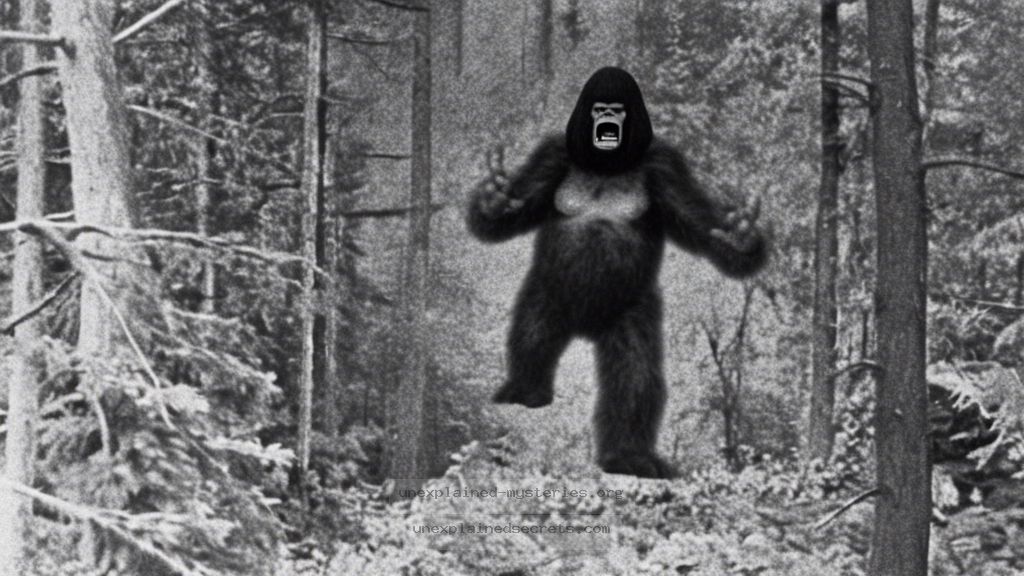Is the Patterson-Gimlin Film the Most Compelling Evidence of Bigfoot’s Existence?
Is the Patterson-Gimlin Film the Most Compelling Evidence of Bigfoot’s Existence?
In the world of cryptozoology, few pieces of evidence are as hotly debated as the Patterson-Gimlin film. Shot in 1967, this short video clip purportedly captures a Bigfoot walking through the woods of Northern California. The film has captivated enthusiasts, skeptics, and researchers alike for decades, raising the question: Is this footage the most compelling evidence of Bigfoot’s existence? In this blog post, we will explore the historical context of the film, analyze its contents, discuss varying perspectives, and evaluate its impact on the ongoing search for this elusive creature.
Historical Context of the Patterson-Gimlin Film
The Patterson-Gimlin film was shot on October 20, 1967, by Roger Patterson and Bob Gimlin in Bluff Creek, California. The duo was on an expedition to find evidence of Bigfoot after hearing local reports of sightings. The film itself lasts just 59.5 seconds, yet it has sparked a multitude of discussions and investigations over the years. Patterson claimed to have captured a female Bigfoot walking through the forest, and the video quickly became a cornerstone of Bigfoot lore.
At the time, the cultural climate was ripe for such a phenomenon. The late 1960s saw a surge in interest in cryptids and unexplained phenomena, fueled by popular culture and the rising counterculture movement. The film was released to the public shortly after it was shot, gaining immediate attention. Skeptics and believers alike began analyzing the footage, leading to a division that persists today.
Analyzing the Footage: What Do We See?
When examining the Patterson-Gimlin film, several key elements warrant attention. The creature appears to walk upright, showcasing a gait that some argue is consistent with human anatomy but also exhibits traits that suggest it is not a human. The figure is covered in dark hair, shows a pronounced breast, and has long arms that swing naturally as it moves. The film quality, while grainy, allows for close examination of these features.
Experts have analyzed the footage using various techniques, including frame-by-frame analysis and motion studies. Some claim that the creature’s movement, particularly its shoulder rotation and knee flexion, is unlike that of a human or any known animal. A 2002 study by Dr. Jeff Meldrum, a prominent anthropologist, suggested that the gait of the creature is more consistent with a bipedal primate than any known human or ape.
Scientific Scrutiny and Skepticism
Despite its status as a cultural artifact, the film has faced significant scrutiny from the scientific community. Critics have pointed out several issues that cast doubt on the authenticity of the footage. They argue that the lack of clear, close-up shots makes it difficult to analyze the creature’s anatomical features critically. Additionally, they highlight the absence of corroborating evidence, such as footprints or hair samples, that would support the existence of Bigfoot.
Another critical point of skepticism comes from the film’s production. Some researchers have suggested that Patterson and Gimlin may have hoaxed the footage. They cite the fact that both men had a vested interest in proving the existence of Bigfoot, as they were actively seeking fame and financial gain from their endeavor. The lack of hard evidence following the film’s release has only fueled these claims, leading many to dismiss it as a clever ruse.
Comparing the Patterson-Gimlin Film to Other Evidence
To assess the significance of the Patterson-Gimlin film, it’s essential to compare it to other forms of evidence that claim to support the existence of Bigfoot. Below is a comparison of notable pieces of evidence:
| Evidence Type | Description | Strength | Weakness |
|---|---|---|---|
| Patterson-Gimlin Film | Footage of a bipedal creature in the woods. | Iconic; widely recognized. | Quality and authenticity questioned. |
| Footprints | Large, human-like footprints found in various locations. | Physical, tangible evidence. | Easily faked; lack of clear biological origin. |
| Audio Recordings | Sounds attributed to Bigfoot, including howls and knocks. | Unique and often unexplained. | Ambiguous; can be attributed to known animals. |
| Eyewitness Accounts | Testimonies from people claiming to have seen Bigfoot. | Numerous and varied. | Subjective; often dismissed as unreliable. |
Core Theories Surrounding Bigfoot
Theories regarding Bigfoot’s existence range from the biological to the mythical. Some researchers propose that Bigfoot is a surviving population of a large primate species, such as Gigantopithecus, which roamed the Earth millions of years ago. This theory posits that these creatures adapted to their environments and evolved to remain elusive to human detection.
Others suggest that Bigfoot may be a cryptid, a creature that exists in folklore and is yet to be scientifically validated. This perspective encompasses the belief that Bigfoot could possess qualities beyond our current understanding of biology, potentially existing in parallel dimensions or as part of a spiritual realm.
Practical Implications of the Patterson-Gimlin Film
The Patterson-Gimlin film has implications beyond mere entertainment; it has influenced public perception of cryptozoology and the scientific community’s approach to unexplained phenomena. For researchers and enthusiasts, the film serves as a rallying point, inspiring continued exploration and investigation into the possibility of unknown species in our forests.
Moreover, the film’s notoriety has led to increased interest in remote wilderness areas, where many believe Bigfoot may reside. This interest can have both positive and negative effects on local ecosystems, as increased tourism can lead to environmental degradation if not managed responsibly.
Alternative Perspectives on Bigfoot’s Existence
While many are fervent believers in the existence of Bigfoot, alternative perspectives shed light on the phenomenon. Some anthropologists suggest that the legend of Bigfoot may be a modern myth, a way for people to explain the unexplained aspects of nature. Others argue that the stories surrounding Bigfoot are a reflection of cultural fears and the human need for mystery in an increasingly rational world.
In Indigenous cultures, tales of large, hairy beings are often deeply rooted in history and spirituality, suggesting that Bigfoot may be a totemic figure rather than a physical entity. These perspectives challenge the notion of Bigfoot as a biological species and frame it more as a cultural artifact.
Common Misconceptions about Bigfoot
Many misconceptions surround the topic of Bigfoot, often stemming from sensationalized media portrayals or anecdotal evidence. One common fallacy is that Bigfoot is merely a figment of imagination or mass hysteria. While it is true that some sightings may be exaggerated or fabricated, this argument dismisses the genuine experiences of countless individuals who claim to have encountered the creature.
Another misconception is that all evidence of Bigfoot is easily debunked. While the Patterson-Gimlin film has its skeptics, it is essential to evaluate each piece of evidence on its own merits rather than generalize its validity. This approach encourages a more nuanced understanding of the phenomenon.
Best Practices for Investigating Bigfoot
For those interested in investigating the existence of Bigfoot, there are several best practices to consider. First, approach the topic with an open mind, recognizing the value of both anecdotal accounts and scientific inquiry. Engaging with local communities and respecting their beliefs is also crucial, as many Indigenous cultures have long-standing connections to the legend of Bigfoot.
Additionally, documenting sightings and collecting physical evidence should be done meticulously. Use technology such as thermal imaging and audio recording devices to gather data that can withstand scrutiny. Building a network of researchers and enthusiasts can also provide support and resources, leading to more comprehensive investigations.
The Future of Bigfoot Research
As we look to the future, ongoing research into Bigfoot continues to expand. Advances in technology, such as DNA analysis and environmental monitoring, may provide new insights into the existence of elusive creatures. Researchers are increasingly collaborating across disciplines, combining knowledge from anthropology, biology, and folklore studies to create a more holistic approach to the mystery of Bigfoot.
Moreover, the rise of citizen science and online communities has democratized the exploration of cryptids, allowing more individuals to participate in research efforts. Social media platforms have become valuable tools for sharing findings and fostering discussions about evidence and sightings.
Conclusion: The Enduring Mystery of Bigfoot
The Patterson-Gimlin film remains a pivotal piece of evidence in the ongoing debate over Bigfoot’s existence. While skeptics question its authenticity, the film continues to inspire curiosity and investigation into the natural world. Understanding the historical context, analyzing the footage, and considering alternative perspectives enrich our comprehension of this enigmatic creature.
As new technologies and methodologies emerge, the search for Bigfoot will likely evolve, incorporating diverse insights and fostering a deeper appreciation for the mysteries that still exist in our world. Whether viewed as a biological entity, a cultural symbol, or a mere figment of imagination, Bigfoot serves as a reminder of the unknown—and our enduring desire to explore it.
Other Articles
Recent Posts
- What Happened to Flight MH370? The Conspiracy Theories That Still Haunt Us
- What Secrets Lurk Within the Walls of the Infamous Trans-Allegheny Lunatic Asylum?
- What Evidence Supports the Existence of Bigfoot in the Pacific Northwest?
- What Happened to the Indus Valley Civilization? Unraveling the Mysteries of Ancient Urban Life
- Can Telepathy Be Scientifically Proven Through Laboratory Evidence?







